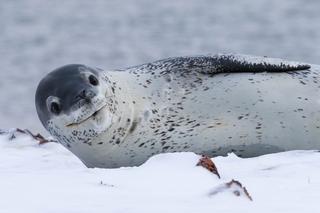PLOS ONE ( IF 2.9 ) Pub Date : 2018-06-05 , DOI: 10.1371/journal.pone.0197767 Iain J. Staniland , Norman Ratcliffe , Philip N. Trathan , Jaume Forcada

|
Leopard seals are an important Antarctic apex predator that can affect marine ecosystems through local predation. Here we report on the successful use of micro geolocation logging sensor tags to track the movements, and activity, of four leopard seals for trips of between 142–446 days including one individual in two separate years. Whilst the sample size is small the results represent an advance in our limited knowledge of leopard seals. We show the longest periods of tracking of leopard seals’ migratory behaviour between the pack ice, close to the Antarctic continent, and the sub-Antarctic island of South Georgia. It appears that these tracked animals migrate in a directed manner towards Bird Island and, during their residency, use this as a central place for foraging trips as well as exploiting the local penguin and seal populations. Movements to the South Orkney Islands were also recorded, similar to those observed in other predators in the region including the krill fishery. Analysis of habitat associations, taking into account location errors, indicated the tracked seals had an affinity for shallow shelf water and regions of sea ice. Wet and dry sensors revealed that seals hauled out for between 22 and 31% of the time with maximum of 74 hours and a median of between 9 and 11 hours. The longest period a seal remained in the water was between 13 and 25 days. Fitting GAMMs showed that haul out rates changed throughout the year with the highest values occurring during the summer which has implications for visual surveys. Peak haul out occurred around midday for the months between October and April but was more evenly spread across the day between May and September. The seals’ movements between, and behaviour within, areas important to breeding populations of birds and other seals, coupled with the dynamics of the region’s fisheries, shows an understanding of leopard seal ecology is vital in the management of the Southern Ocean resources.
中文翻译:

南极海底捕食者的长期运动和活动方式:豹海豹
豹海豹是重要的南极天敌,可以通过局部捕食影响海洋生态系统。在这里,我们报告了微型地理位置测井传感器标签成功使用跟踪四个豹子海豹在142至446天之间的旅行(包括一个人在单独的两年中)的运动和活动的情况。尽管样本量很小,但结果表明我们对豹纹海豹的了解有限。我们展示了在接近南极大陆的浮冰和南乔治亚南部亚岛之间追踪豹海豹迁徙行为的最长时间。这些被追踪的动物似乎以有针对性的方式向鸟岛迁移,并在其居住期间将其用作觅食旅行以及开发当地企鹅和海豹种群的中央场所。还记录了向南奥克尼群岛的迁移,这与该地区其他磷虾捕捞者(包括磷虾渔业)中观察到的类似。考虑到位置误差,对栖息地协会的分析表明,追踪到的海豹对浅层架水和海冰区域具有亲和力。干湿传感器显示,密封件在22%到31%的时间内运行时间最长,最长为74小时,中位数为9至11小时。海豹在水中停留的最长时间为13到25天。拟合GAMMs显示,全年的出勤率发生变化,夏季出现最高值,这对视觉调查有影响。高峰拖运发生在10月至4月之间的中午左右,但在5月至9月之间的一天中分布更为平均。

































 京公网安备 11010802027423号
京公网安备 11010802027423号